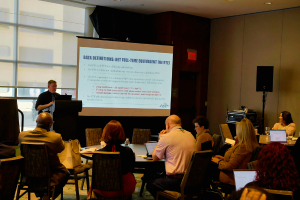
By Paulina Duque, Communications Coordinator, AACRAO, Live from SEM 2024
You’ve built your Strategic Enrollment Management (SEM) plan. You’re enrolling more students. Your retention rates are up. But you are still short on cash when it comes time to pay the institutional bills. What do you do? For some time, the institutional answer to the problems of financial hardships has been to enroll more students. If you bring in more students, the money will follow, right? After all, a college education isn’t always free. However, with the inevitable enrollment cliff, there may not be more students to enroll.
Dr. Steve J. McKellips, Vice Provost for Enrollment Management at the University of Akron, shared his new approach to combating this issue and surviving the inevitable and ever-present enrollment cliff at the 2024 SEM Conference in Boston. Dr. McKellips explained in this workshop, “Introducing FEM: Forensic Enrollment Management to Unlock Institutional Revenue,” that the approach splits enrollment management and strategic enrollment management to identify where you might be missing out on revenue and how to find opportunities to maximize it.
So, why is this being introduced now? One of the pertinent problems facing higher education today, which has been a problem for years now, is how institutions can pay their bills when enrollment numbers are trending downward. Knowledge of a looming enrollment cliff has been present for years. As higher education gets closer to reaching the perceived enrollment cliff, some are starting to think that the implications of the enrollment cliff might be too optimistic. To some, the cliff is beginning to look more like a trench—this perception expresses the hopes that higher education could bounce back from the cliff. However, the reality of sinking enrollment numbers drowns out the persisting growth mindset of higher education and drifts into one of scarcity. Having an SEM plan for your institution to systematically improve recruitment, retention, and graduation rates is critical for creating your institutional roadmap to build up your student population and ensure your learners' success.
To understand FEM, there are five concepts to grasp beforehand:
- There must be an understanding that enrollment is not a proxy for revenue.
- FEM lives on the enrollment management and strategic enrollment management spectrum.
- This FEM approach uses Cost of Delivery (COD) as the foundational characteristic of an institution's fiscal needs.
- There cannot be multiple CODs for a single institution and the formula for determining the COD cannot be changed.
- Affordability is different for all students. Simply enrolling students does not solve all problems if you’re enrolling students who can't afford school.
“Students will enroll when the price matches their perceived value,” explained Dr. McKellips in his workshop. Somewhere in the enrollment process between the time we admit a student to an institution and a student enrolls, the student is made aware of their tuition costs and financial aid offers. The FEM approach fits into this enrollment process and can allow you to find more revenue by first asking how much each student can afford and then asking that student to pay what they can afford.
Dr. McKellips highlighted the importance of aligning enrollment strategies with the financial realities of students as well as with the financial needs of your institution. Dr. McKellips introduced the concept of calculating the Net Full-Time Equivalent (NetFTE). This is done by removing student credit hours the university cannot use to generate revenue, such as dual enrollment, and focusing on the need to count only regular tuition-paying students to measure revenue generation accurately. He suggested calculating the NetFTE to find the true cost of delivery per student, then setting the Net Target Revenue accordingly, and aiming for a surplus rather than just breaking even.
The new pre-conference workshop by Dr. McKellips introduced new concepts, outlined strategies, and demonstrated how institutions can incorporate the FEM approach to find revenue for their institution and create practical and strategic enrollment and retention goals. FEM introduces a new approach within your SEM planning that could be the key to keeping your institution's doors open and financially afloat.